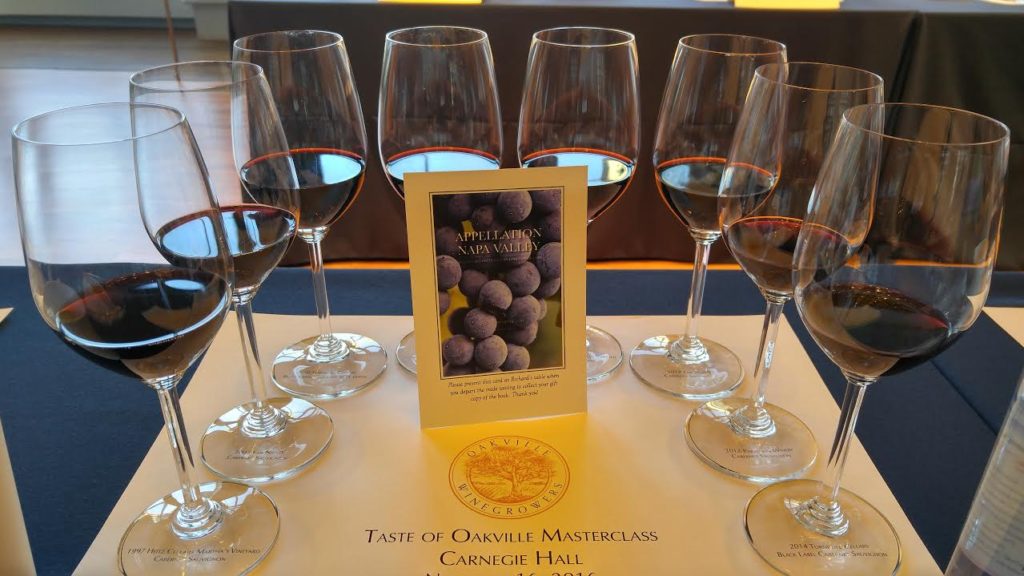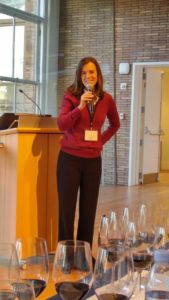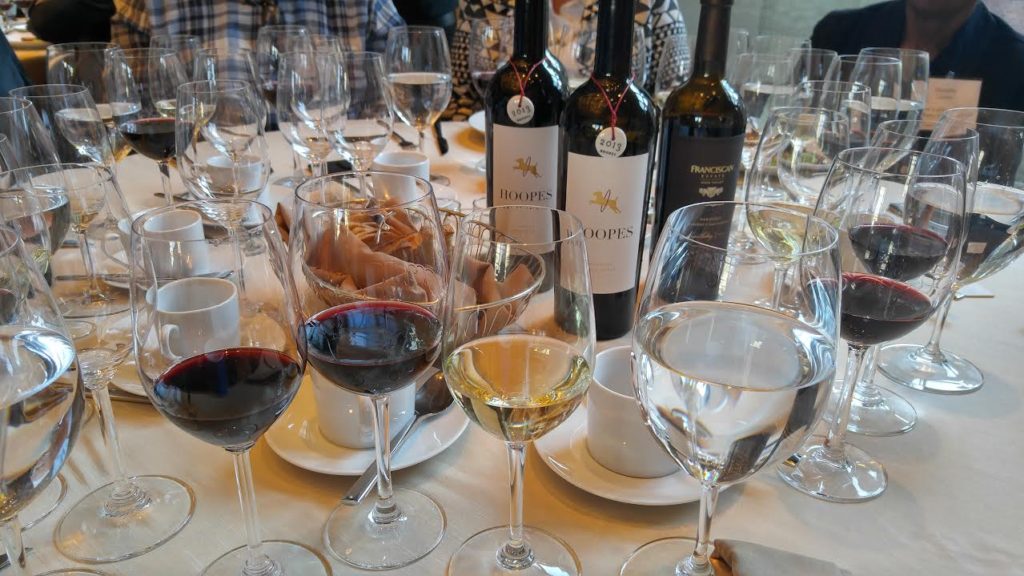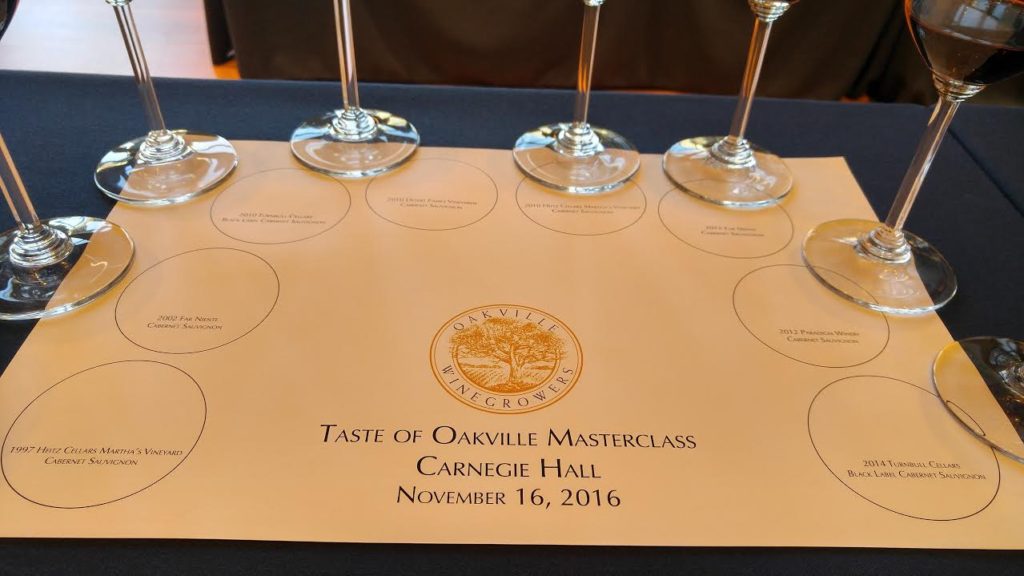 I found it incredibly fascinating to learn more about the AVA system (American Viticultural Area) at the Oakville Master Class in New York City on November 16th. It was not only a lesson on the why, how and what in regards to areas of production that are noted on the label of American wines, especially focusing on Napa Valley, but the deeper meaning of how all of us need to define ourselves if we want to have any say in our future.
I found it incredibly fascinating to learn more about the AVA system (American Viticultural Area) at the Oakville Master Class in New York City on November 16th. It was not only a lesson on the why, how and what in regards to areas of production that are noted on the label of American wines, especially focusing on Napa Valley, but the deeper meaning of how all of us need to define ourselves if we want to have any say in our future.
AVA vs AOC
 Let me just touch on what an AOC is since it is a system that was developed long before our American Viticultural System. AOC stands for Appellation d’Origine Contrôlée or sometimes people just call it AC… it was superseded by the Appellation d’Origine Protegée (AOP) so this designation of origin would have more validity in court. So, even though some French producers may be a little peeved at me, let’s use the term AOC since that is the one many French wine drinkers are most familiar with…
Let me just touch on what an AOC is since it is a system that was developed long before our American Viticultural System. AOC stands for Appellation d’Origine Contrôlée or sometimes people just call it AC… it was superseded by the Appellation d’Origine Protegée (AOP) so this designation of origin would have more validity in court. So, even though some French producers may be a little peeved at me, let’s use the term AOC since that is the one many French wine drinkers are most familiar with…
Okay, what does the AOC do? Good question. It is a system that defines areas of wine production and regulates the parameters of the wines made, such as grape variety, in that specific AOC. For example, various red Burgundy AOCs define the grape variety to be Pinot Noir and the whites defined to be Chardonnay. Of course there are exceptions – can I offer you a glass of Saint-Bris?
 Since France began making wine way before America, it was France that helped to inspire many great American wine producers to set up a structure for their different wine regions, with Napa Valley being one of the most famous to follow their lead. Richard Mendelson, one of America’s preeminent wine lawyers, talked during this seminar about an apprenticeship, during his early days of post-graduate work, at a winery in Burgundy guiding him in how he assisted shaping the American system of appellations. Also, he expressed how France inspired many of the key figures that made Napa Valley what it is today.
Since France began making wine way before America, it was France that helped to inspire many great American wine producers to set up a structure for their different wine regions, with Napa Valley being one of the most famous to follow their lead. Richard Mendelson, one of America’s preeminent wine lawyers, talked during this seminar about an apprenticeship, during his early days of post-graduate work, at a winery in Burgundy guiding him in how he assisted shaping the American system of appellations. Also, he expressed how France inspired many of the key figures that made Napa Valley what it is today.
And so, a system like the AOC, that would designate areas based on commonality of history, community identity, topography and sense of place, was created, although the American version, the AVA, does not have a “playbook” as Mendelson called it, so it does not set parameters that restrict the producer. For example, the AVA does not force a producer to grow a certain variety(ies). Mendelson explained that since we were such a young winemaking country, we needed time to sort out what worked best in particular vineyard sites – and he said that we are still figuring that out.
Napa Valley AVA
Napa Valley was the second designated AVA in the US, only second to the Missouri AVA, and that’s only because it took Napa a lot longer to figure out where the boundaries would be drawn.
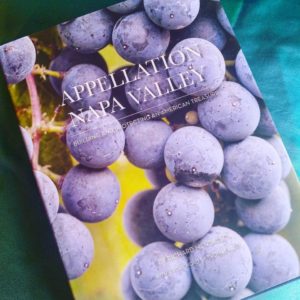 It was an incredible experience to hear Richard Mendelson talk, since he himself not only witnessed some of the most significant events in the history of American wine but he was a part of it. That experience was enhanced by his book, which we were given, Appellation Napa Valley: Building and Protecting an American Treasure. It is a big, hard covered book, deservedly so, since it not only documents the intricacies of setting up the Napa Valley AVA and its subsequent sub-AVAs, but there needed to be room for all the maps that truly give one a deep understanding of why boundaries were drawn the way they were and the impact of these final decisions. Mendelson creates a picture and journey that is so vivid that I could imagine being in those rooms when these passionate discussions between the legends of the Napa wine community were taking place.
It was an incredible experience to hear Richard Mendelson talk, since he himself not only witnessed some of the most significant events in the history of American wine but he was a part of it. That experience was enhanced by his book, which we were given, Appellation Napa Valley: Building and Protecting an American Treasure. It is a big, hard covered book, deservedly so, since it not only documents the intricacies of setting up the Napa Valley AVA and its subsequent sub-AVAs, but there needed to be room for all the maps that truly give one a deep understanding of why boundaries were drawn the way they were and the impact of these final decisions. Mendelson creates a picture and journey that is so vivid that I could imagine being in those rooms when these passionate discussions between the legends of the Napa wine community were taking place.
During the seminar, Mendelson was always careful to make sure he was explaining the legalities of certain statements but it was always colored with his obvious gratitude that his life was enriched by the wine community. He said that as a lawyer he has worked with many commodities, and by comparison, nothing was as wonderful as working with “growers and vintners” as he felt that their proceedings were like no other. The people involved understand “that these boundaries may last forever”, and so they are happy to take their time to make sure they are doing the right thing, not only in regards to what is fair to everyone involved, but what is ultimately right for a distinctive AVA labeled area.
Impetus for Defining
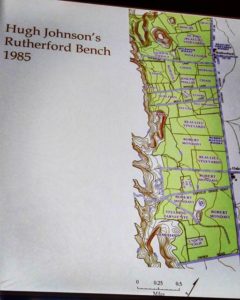 Oakville and Rutherford are both sub-AVAs that are famous today, but at one time they were not officially designated. The impetus to designate these specific places came from the 1985 version of Hugh Johnson book, Atlas of Wine (the most updated version is one of my favorite wine books today). Now let me first preface this by saying that not only did Mendelson express his high admiration for Johnson, but I have always looked up to him and I am always immensely blown away by his skill and insane amount of talent when it comes to writing about wine. But back to the 1985 Atlas of Wine – in this edition, there was a defined area called the Rutherford Bench that was partly in Rutherford and party in Oakville. It became apparent to producers in both areas that they needed to legally define their own area or the press and outsiders would have no choice but to sort it out for themselves.
Oakville and Rutherford are both sub-AVAs that are famous today, but at one time they were not officially designated. The impetus to designate these specific places came from the 1985 version of Hugh Johnson book, Atlas of Wine (the most updated version is one of my favorite wine books today). Now let me first preface this by saying that not only did Mendelson express his high admiration for Johnson, but I have always looked up to him and I am always immensely blown away by his skill and insane amount of talent when it comes to writing about wine. But back to the 1985 Atlas of Wine – in this edition, there was a defined area called the Rutherford Bench that was partly in Rutherford and party in Oakville. It became apparent to producers in both areas that they needed to legally define their own area or the press and outsiders would have no choice but to sort it out for themselves.
And so, the main leaders on both the Oakville and Rutherford sides decided that they needed to come together to figure out for themselves the following questions: Where was Oakville? Where was Rutherford? Where was the Rutherford Bench? Where was the Oakville Bench? Mendelson was a member of the team establishing the Oakville boundaries from the very beginning until the end and he said it took four years. Again, this illustrates the seriousness of which everyone took this decision.
Since many questioned where the “Bench” really existed, and some even questioned if it existed at all, it was decided that there would not be an official AVA for either the Rutherford or Oakville Bench. And just a further example of the community sticking together, they were afraid that designating a “Bench” would make those from the regular AVAs, who are not part of the “Bench”, second class citizens. Some used the example of the 1855 classification in Bordeaux and how some Châteaux felt they were given an unwarranted lower classification. For example today, a 5th growth like Pontet-Canet has had some of their vintages considered on par with 1st growths, but they are still considered a 5th growth, and cannot command a 1st growth’s price.
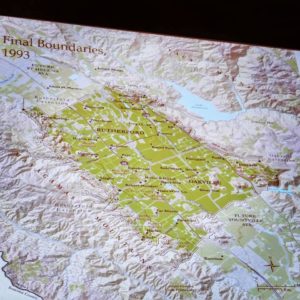 And so, in 1993, they defined the exact boundaries of Oakville and Rutherford as separate AVAs with the “Bench” idea left off the table. Even though it is interesting to note that although some producers will refer to vineyards being in the “Bench” in their marketing material, it is not a legally defined term.
And so, in 1993, they defined the exact boundaries of Oakville and Rutherford as separate AVAs with the “Bench” idea left off the table. Even though it is interesting to note that although some producers will refer to vineyards being in the “Bench” in their marketing material, it is not a legally defined term.
What Happens If We Don’t Define Ourselves?
This seminar was already filled with a wealth of tantalizing information and experiences but there was something that happened that I think many people in that room had never experienced. It is worth noting that this seminar was held in the Carnegie Hall building, where some of the greatest musicians in the world have played. It was serendipitous that a Sommelier present at the seminar was also an opera singer, and so he sang Danny Boy… it was simply exquisitely sung with such depth and emotion.
It is impossible to hear that song without thinking of my step-father. He loved that song. It was one of the songs he wanted played at his funeral. It always made him sad, but when I would asked him why he had tears in his eyes when he heard it he simply could not express exactly why. He thought it was a song about a father saying goodbye to his son… possibly never seeing him again. He had kids young and he thought he was not the best father, provider and he did express guilt about wishing he could have relived it. Even though his kids tried to reach out to him as they became adults and form a close relationship he allowed his own regret to hold him back. He allowed that early part of his life to define him and so his low self esteem made him settle for certain things he should have never settled for…
In that moment, listening, it was incredible to see this sommelier, Haksoo Kim, spread his wings and fly… he took us along for the ride showing us that we were a lot more than we have allowed ourselves to dream.
Oakville AVA
Oakville was a community that decided to stand up and define themselves as being a special place that was worth noting… and they talk as if there is still a lot more growth for them on the horizon… they see their future potential problems as opportunities to dig deeper into what their magnificent vineyards have to offer. They know the work has only just begun and they look foreword to another chapter in their lives and their children’s lives.
Defining Ourselves
How we define ourselves is always a work in process… just like the wine world – we evolve with the different experiences and challenges that are presented to us. But if we are going to live through all the trials that life has to offer, then we might as well define who we are and not allow others to place us in a box. Whether good times or bad, leaps or falls, we can always ground ourselves in the idea that our greatness never alters, it is sometimes just forgotten – or in my step-father’s case, buried in a deep, dark hole that he never realized was there.
It is not too late to define ourselves to the world. Some may not like it, some may have no interest, but in the end we will never know the life that we are supposed to live unless we stand up and be counted.
****************
The following are all Cabernet Sauvignon wines from Oakville that were tasted during the Master Class:
 –1997 Heitz Martha’s Vineyards Cabernet Sauvignon (winery located in St. Helena but vineyard located in Oakville): 100% Cabernet Sauvignon. Rich, lots of blackberry fruit, round tannins with a full body and long bright finish that had a lift of mint. A lush wine that still has that Heitz elegance.
–1997 Heitz Martha’s Vineyards Cabernet Sauvignon (winery located in St. Helena but vineyard located in Oakville): 100% Cabernet Sauvignon. Rich, lots of blackberry fruit, round tannins with a full body and long bright finish that had a lift of mint. A lush wine that still has that Heitz elegance.
This wine is a special commemorative cuvee honoring the late Joe Heitz and his relationship with Tom and Martha May. Kathleen Heitz Myers, daughter of the founders as well as President and CEO of Heitz Cellars, told the story of Martha’s vineyard – the first single vineyard in the US for Cabernet Sauvignon. But before she told the story, she pointed out Tom and Martha’s daughter in the audience, Laura May Everett, and prefaced her story with “Laura and I are like sisters. We’ve known each other through good and bad, growing up together. We know each other’s secrets. Our company takes the long view. We stand by each other through tears and happiness.”
She then told the story of Martha’s vineyard as a property that Tom and Martha May bought in 1963 – right after they were married – and at the time, had no idea that this was “the vineyard”. In 1965, the Mays paid Joe and Alice Heitz a visit to see if they wanted to buy their grapes – and history was made. Joe Heitz thought the wine was so special because of the vineyard that he thought he should label it to give the Mays credit somehow. So Joe talked to Tom about what he would like to call the vineyard… one day Tom was driving behind a boat that had the name of a woman on it, and so, he named the vineyard after his wife, Martha – who was embarrassed by the gesture but the name stuck. And so for the 1966 vintage, Martha’s Vineyards was placed on the label. Since then, the grape variety has naturally morphed and evolved and has become its own proprietary clone (or biotype) called Martha’s Cabernet Sauvignon – which features small berries, long, loose bunches, intense color and aromatics and is known for a minty note.
–2002 Far Niente Estate Bottled: 90% Cabernet Sauvignon and 10% Petit Verdot. Deep ruby color, floral, soft tannins, juicy creme de cassis with flavorful finish.
Larry Maguire, President and CEO of Far Niente, said that when they write a comprehensive book about Napa Valley, there should be a whole chapter devoted to Richard Mendelson. He said that anytime he is sent some random “cease and desist” letter he immediately calls Mendelson who quickly works to help him out.
–2010 Turnbull Cellars, Black Label: 100% Cabernet Sauvignon. Stewed plums, blueberry pie, sweet, big and plush tannins.
This wine comes from two areas in the Oakville Bench (Leopoldina and Fortuna) and Western rolling hills of Calistoga (Amoenus)
Peter Heitz, Winemaker for Turnbull Wine Cellars, no relation to Kathleen Heitz Myers but they have been friends for many years, said that part of Oakville’s success was due to the fact that people share their experiences and knowledge gathering together for meetings at the UC Davis station, located in Oakville. He said this idea of cooperation for the greater good across Napa Valley as a whole accomplished the feat of eradicating the European Grape Moth within 5 years of working together.
–2010 Detert Family Winery: Big, broad structure that has pure black currant flavor and a refined finish.
The Detert vineyard is surrounded by the famous To Kalon vineyard, but it cannot call themselves To Kalon on the label since Robert Mondavi owns the trademark to To Kalon and has an agreement to share that name with Beckstoffer but Detert is not part of that agreement.
–2010 Heitz Martha’s Vineyards: 100% Cabernet Sauvignon. Focused and elegant, not as lush or jammy as the 1997… stunning violet notes with incredible energy.
–2012 Far Niente Estate Bottled: 94% Cabernet Sauvignon, 5% Petit Verdot and 1% Cabernet Franc. Exotic spice, a great backbone of structure with hints of vanilla on the finish will make this a long lived wine.
–2012 Paradigm Winery: 96% Cabernet Sauvignon, 3% Merlot and 1% Petit Verdot. They said that 2012 was a great vintage where they made their ideal wine… lots of black fruit, mid-weight on the palate and richness… this wine has a flavor of lush, ripe black cherries with sweet spice and nice fleshy body that makes it very appealing now.
–2014 Turnbull Cellars, Black Label: 100% Cabernet Sauvignon. Smoky ash, dark brooding fruit with a beautiful, lifted nose of wild flowers that really made it stand out.
Peter Heitz, Winemaker for Turnbull Wine Cellars, said that even though the 2014 is not ready to drink he still wanted to show it since he thinks the wine is exciting. When asked about vintages he said that he originally thought the 2014 was only going to be a mediocre vintage but he thinks that it may end up being one of the greatest vintages in modern times.
The following wines were tasted after the Master Class during lunch:
 –2013 Hoopes Vineyards, Cabernet Sauvignon: Black currant preserves, cinnamon and velvety tannins.
–2013 Hoopes Vineyards, Cabernet Sauvignon: Black currant preserves, cinnamon and velvety tannins.
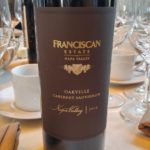 –2013 Franciscan Estate, Cabernet Sauvignon: Dusty, opulent, rich, blackberry, spice and tobacco leaf.
–2013 Franciscan Estate, Cabernet Sauvignon: Dusty, opulent, rich, blackberry, spice and tobacco leaf.
 –2014 Robert Mondavi Winery, Fumé Blanc, Sauvignon Blanc, To Kalon Vineyard: Lots of textural complexity with delicious notes of honeysuckle and white peach. Many people agree that very few did as much for the prestige of Napa Valley than Robert Mondavi.
–2014 Robert Mondavi Winery, Fumé Blanc, Sauvignon Blanc, To Kalon Vineyard: Lots of textural complexity with delicious notes of honeysuckle and white peach. Many people agree that very few did as much for the prestige of Napa Valley than Robert Mondavi.
 –2014 Tor Kenward Family Wines, Cabernet Sauvignon, Tierra Roja Vineyard: A sexy, extremely attractive wine that grabs you from the first taste with sensual flavors of sweet black berry that is balanced by a undertone of earth.
–2014 Tor Kenward Family Wines, Cabernet Sauvignon, Tierra Roja Vineyard: A sexy, extremely attractive wine that grabs you from the first taste with sensual flavors of sweet black berry that is balanced by a undertone of earth.
 –2013 Oakville Ranch, Cabernet Sauvignon: An opulent wine with silky tannins that has well-integrated oak and a refined aromatic finish.
–2013 Oakville Ranch, Cabernet Sauvignon: An opulent wine with silky tannins that has well-integrated oak and a refined aromatic finish.

